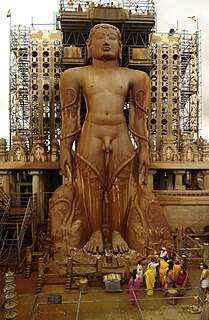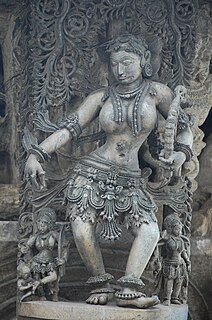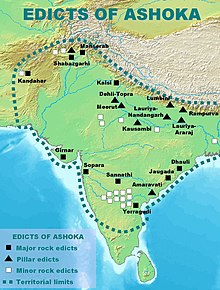
Sanchi is a Buddhist complex, famous for its Great Stupa, on a hilltop at Sanchi Town in Raisen District of the State of Madhya Pradesh, India. It is located, about 23 kilometres from Raisen town, district headquarter and 46 kilometres (29 mi) north-east of Bhopal, capital of Madhya Pradesh.
Nala Sopara or Nallasopara formerly known as Sopara or Supara, is a town within the Mumbai Metropolitan Region. The town lies in the Palghar district of Maharashtra, India and is governed by Vasai-Virar Municipal Corporation (VVMC). Nalla Sopara railway station is part of the Western Railway Zone.

The Satavahanas, also referred to as the Andhras in the Puranas, were an ancient South Asian dynasty based in Deccan. Most modern scholars believe that the Satavahana rule began in the late second century BCE and lasted until the early third century CE, although some assign the beginning of their rule to as early as the 3rd century BCE based on the Puranas, but uncorroborated by archaeological evidence. The Satavahana kingdom mainly comprised the present-day Andhra Pradesh, Telangana, and Maharashtra. At different times, their rule extended to parts of modern Gujarat, Madhya Pradesh, and Karnataka. The dynasty had different capital cities at different times, including Pratishthana (Paithan) and Amaravati (Dharanikota).

The Bhima River is a major river in Western India and South India. It flows southeast for 861 kilometres (535 mi) through Maharashtra, Karnataka, and Telangana states, before entering the Krishna River. After the first sixty-five kilometers in a narrow valley through rugged terrain, the banks open up and form a fertile agricultural area which is densely populated.

Shravasti was the capital of the ancient Indian kingdom of Kosala and the place where the Buddha lived most after his enlightenment. It is near the Rapti river in the northeastern part of Uttar Pradesh India, close to the Nepalese border.

Kalaburagi district, formerly known as Gulbarga district, is one of the 31 districts of Karnataka state in southern India. Kalaburagi city is the administrative headquarters of the district. The district is the headquarters of Kalaburagi division.
The Archaeology of Ayodhya concerns the excavations and findings in the Indian city of Ayodhya in the state of Uttar Pradesh, much of which surrounds the Babri Mosque location.
Chitapur or Chittapur is a Town and Taluk in Kalaburagi district in the state of Karnataka, India. It is also the headquarters of the Chittapur taluk. It is known for polished stones and toor dal.
Pauni is a town and a Municipal Council in Bhandara district in the Indian state of Maharashtra. Now it has National Highway NH-247. Pauni is also known as Kashi of Vidarbha due to its wide swath of temples.

Karnataka, the sixth largest state in India, has been ranked as the third most popular state in the country for tourism in 2014. It is home to 507 of the 3600 centrally protected monuments in India, the largest number after Uttar Pradesh. The State Directorate of Archaeology and Museums protects an additional 752 monuments and another 25,000 monuments are yet to receive protection. Tourism centres on the ancient sculptured temples, modern cities, the hill ranges, forests and beaches. Broadly, tourism in Karnataka can be divided into four geographical regions: North Karnataka, the Hill Stations, Coastal Karnataka and South Karnataka.

A salabhanjika or shalabhanjika is a term found in Indian art and literature with a variety of meanings. In Buddhist art, it means an image of a woman or yakshi next to, often holding, a tree, or a reference to Maya near the sala tree giving birth to Siddhartha (Buddha). In Hindu and Jain art, the meaning is less specific, and it is any statue or statuette, usually female, that breaks the monotony of a plain wall or space and thus enlivens it.

Thotlakonda Buddhist Complex is situated on a hill near Bheemunipatnam about 15 kilometres (9.3 mi) from Visakhapatnam in Andhra Pradesh, India. The hill is about 128 metres (420 ft) above sea level and overlooks the sea. The Telugu name Toṭlakoṇḍa derived from the presence of a number of rock-cut cisterns hewn into the bedrock of the hillock. In 2019, the stupa was partially damaged due to monsoons, but it was restored by 2021 at the cost of Rs 42 lakh.
Buddhism in Northern Karnataka has seen major development after the discovery of an Ashoka inscription at Maski in Raichur District a few decades ago and of a Buddhist settlement through a series of archaeological excavations at Sannati which have shed light on the historic significance of Karnataka.

Ganagapura is a Village in Karnataka, India. It is located in the Afzalpur taluk of Kalaburagi district in Karnataka.The Village is noted for its Temple to Lord Dattatreya, who is said to have attained realization on the banks of the confluence (Sangama) of rivers Bhima-Amarja.
Kanganahalli, situated about 3 km from Sannati, is an important Buddhist site where an ancient Mahastupa was built. It is on the left bank of the Bhima river in Chitapur taluk, Kalaburagi district in Karnataka, India. Nalwar is the nearest Railway station about 19 km from Sannati. The Buddhist site about 2.5 km from Chandrala Parameshwari temple of Sannati.

Yadgir District is one of the 31 districts of Karnataka state in southern India.This district was carved out of Kalaburagi district as the 30th district of Karnataka on 10 April 2010. Yadgir town is the administrative headquarters of the district. The district occupies an area of 5,160.88 km2 (1,992.63 sq mi).
Adi Badri, also Sri Sarasvati Udgam Tirath, is a tourist site of archaeological, religious and ecological signifiance in a forest area in the foothills of the Sivalik Hills in Bhabar area, situated in northern part of Yamunanagar district, of the north Indian state of Haryana. There are remains of many Buddhist stupas and monasteries, which are about 1500–2000 years old, and there is also a group of Hindu temples from the 9th century. Based on the multiple archaeological excavations undertaken here, archaeologists have sent the proposal to Archaeological Survey of India (ASI) to include this site in the list of protected heritage site. Several popular annual festivals are held here, including the five day long National Saraswati Festival in January, Adi Badri Akha Teej Mela in Vaisakh around April–May, week-long Adi Badri-Kapal Mochan Kartik Purnima religious mela around November.

The Amarāvati Stupa, popularly known as the great stūpa at Amarāvathi, is a ruined Buddhist monument, probably built in phases between the third century BCE and about 250 CE, at Amaravathi village, Palnadu district, Andhra Pradesh, India. The site is under the protection of the Archaeological Survey of India. The campus includes the stūpa itself and the Archaeological Museum.
Inguva Kartikeya Sarma was an Indian archaeologist and a director of the Salar Jung Museum.

The Buddhist caves in India. Maharashtra state Aurangabad Dist. Ellora caves form an important part of Indian rock-cut architecture, and are among the most prolific examples of rock-cut architecture around the world. There are more than 1,500 known rock cut structures in India, out of which about 1000 were made by Buddhists, 300 by Hindus, and 200 by Jains. Many of these structures contain works of art of global importance, and many later caves from the Mahayana period are adorned with exquisite stone carvings. These ancient and medieval structures represent significant achievements of structural engineering and craftsmanship.
















